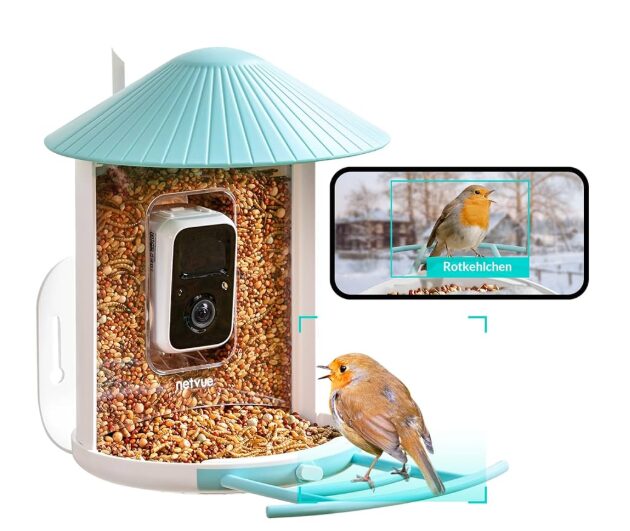Attract More Birds to Your Bird Feeder Camera: Tips for Better Footage

It is relaxing and thrilling to sit and observe birds flying in and out of your bird feeder. But it becomes more exciting when you can use a bird feeder camera to capture these beautiful moments and share them with your fellows.
Whether you are a backyard birding enthusiast or an avid photographer, you must get more birds to your place to improve the quality of your footage. For this, it is not enough to place a smart bird feeder. It requires a proper combination of food, placement of feeders, shelter, and a plan to make your bird feeder a powerful bird hotspot.
In this article, we will share some professional tips to attract more visitors and capture clear, amazing videos every day. So, keep reading it till the end!
1. Select the Appropriate Food
Various bird species are conscious of what they eat. One of the most crucial things in attracting a variety of birds is to provide them with the appropriate form of seed or food composition. A speedy bird food guide is given below:
- Black sunflower seeds: Nuthatches, Chickadees, and Cardinals like to eat these seeds.
- Nyjer (thistle) seeds: Finches, especially Goldfinches, love Nyjer seeds because they are full of thick oils.
- Suet: This is the right seed that feeds on woodpeckers during winter.
- Millet: Sparrows, doves, and juncos like it best.
- Peanuts: These are favorites of Jays and Titmice.
Select the food based on regional and seasonal birds. Birds usually eat low-fat foods like fruits or seeds in the summer, but in the winter, they prefer high-fat foods like suet.
2. Offer Different Bird Feeders
Don’t rely on a single feeder! Put different types of bird feeders in your garden. Hoppers, suet cages, platform feeders, and tube feeders attract different species of birds. If you want to add a smart bird feeder camera, make it strategically positioned along with other feeders so that it will enable you to see more visitors.
Through the use of other kinds of bird feeders, you will not only make your backyard look beautiful but also invite more birds to greet you and monitor them with your camera.
3. Strategically Position Your Bird Feeder Camera
It’s all about feeder placement to find clear and high-quality footage. This is what you will have to keep in mind:
- Height: It is advisable to attach the feeder to a tree or a pole that is almost 5-6 feet high to prevent predators and provide a convenient viewing angle.
- Background: Birds are to be captured on an organic background like trees and solar flowers. It enhances the beauty of your video.
- Light direction: Put your bird feeder in a sunlit place where it receives a lot of sunlight, but do not place it at an angle that will face the sun, resulting in glare.
- Safety distance: Birds prefer feeders near cover (bushes, trees), but not too near that predators, such as hawks or cats, can use them as a hiding spot.
A smart bird feeder camera also consists of many other advanced features. It can sense motion and record high-quality videos and pictures of the birds that come to the feeder.
4. Create a Bird-Friendly Environment
Birds are not only going to feed; they are also attracted to safe and friendly environments. The following is how you can make your backyard bird-friendly:
- Native plants: These are natural shrub plants and nectar plants, which produce berries, and seed plants, like grasses, which are the natural sources of food.
- Water sources: The water supplies found in a bird bath or just a small fountain will supply the drinking and bathing water. Birds would love to return there if they get all they need at one location.
- Shelter: Add trees, shrubberies, and brush piles in your garden. Such shelters provide birds a safe place to sleep and make nests.
The more natural and safe your backyard looks, the more the chance that birds will come by often, which will help you get better clips of your favorite birds.
5. Be Patient and Consistent
Keep in mind that birds will not come in one day. Within days or even weeks, they might find a new feeder, particularly when you start your activity. The feeder should be filled at all times, cleaned, and stationed in a place that commands trust.
What is most valuable is how just once birds know your smart bird feeder and they manage to use it successfully, they will use it again and again, which will leave you with a good show to observe and share.
6. Take Care of Your Bird Feeder
Dirty feeders can also keep birds away because they can get sick from them. Make a solution of 1:10 bleach and water to clean your bird feeders once or twice a week. Replace the container with clean water and rinse it out.
Another method that you should frequently use is cleaning your camera lens in order to take clear and clean pictures and videos that are not accompanied by dust, dirt, or even water splashes.
7. Use A Smart Bird Feeder
Investing in a smart bird feeder camera improves your birdwatching experience. Consider the following features while buying it:
- Integrated 4K or HD cameras
- Motion detection that begins recording when a bird visits
- Wi-Fi access to broadcast live content to your phone
- AI-powered identification of bird species
- Night vision for activities in dim light
The smart technology not only helps you attract birds but also creates a digital bird journal featuring appealing images and valuable knowledge.
8. Follow Visits and Look at Patterns
A bird feeder with camera enables you to track bird visits and collect species data. You can identify a bird species by using this information:
- Peak feeding hours
- The most prevailing visitors
- Changes with seasons in the bird activity
With this knowledge of the timings, you can arrange your feeding schedule accordingly and alter your arrangement to make it more bird-friendly.
Conclusion
The most effective bird shot is neither based on setting a bird feeder camera in the right position nor on providing a place where birds can feel welcome, safe, and fed. Whether it is providing the best food or keeping your feeder clean, every single detail counts towards an improvement in birdwatching and more interesting shots as well.
These tips allow you to maximize your smart bird feeder system, whether you are a hobbyist or a content creator posting wildlife online. With some patience and proper tactics, your backyard can become an energetic hub of feathered activity, and your captured photos and videos will demonstrate it.





